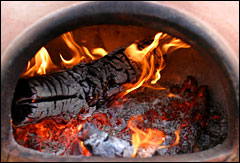Dear Umbra,
What should we do with ashes from the fireplace? I’ve heard that they’re great for the garden and I’ve heard that they may not be so good for the garden. Are they a good replacement for salt on slippery sidewalks?
Janet Allen
Syracuse, N.Y.
Dearest Janet,
Why not make some soap? Here come the holidays, after all. All you’d have to do is run water over the ashes to make potash, boil the potash down into lye, render your old cooking grease, mix it with the lye, not get any chemical burns, let it all cure for a while and then mill it into lovely gift bars. I suppose it would have been best to start saponificating in the summer, and do it all outdoors. You could save your ashes and make your own potash in the spring rains.

Get your ash out to the garden … or not.
Photo: iStockphoto
If that doesn’t appeal, then yes, you can probably put wood ash on your garden. The ashes and nutrients that were in the tree and remain after a fire are beneficial soil amendments (that means: can change the soil in a good way). As with any soil amendment, however, it’s important to know what’s in the stuff and whether your garden needs the particular nutrients. The chemical makeup of wood ash will depend of course on the tree that was burned, and also on how hot it burned, so there’s less exactitude with wood ash than with a commercially prepared soil amendment. But it’s free, and you’ll be returning it to the soil whence it came.
Wood ash is an alkaline substance, a base. It is often used to lime soils, that is, to raise the pH of acid soil. Potassium is the significant available nutrient, and it is also high in salt. Because of the alkalinity, and the salt, it’s not a good idea to chuck the stuff willy-nilly about the yard. You might end up over-salting the soil, choking on the ash, or disappointing/killing acid-loving plants. I’ve found two clear resources that give ballpark amounts to apply in the garden, and tips on how to apply the ash, one from Oklahoma Extension and the other from Oregon Extension. It’s best to get a soil test, of course, so that you know the pH of your soil and whether you’re low in potassium. Ash can also be added to compost piles and used very sparingly as a pest deterrent — read all the specific instructions in these Extension publications.
As for using your ash on slippery sidewalks: I think it works, but with the major drawback of wet ash on your shoes. You alone can decide if you are willing to deal with the resultant mess.
Wishing you a warm home.
Potashly,
Umbra

